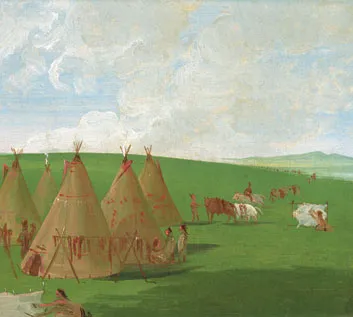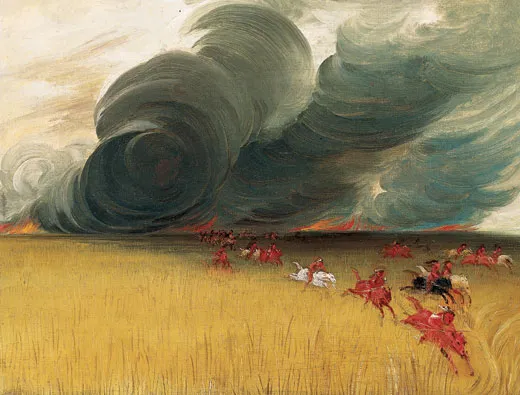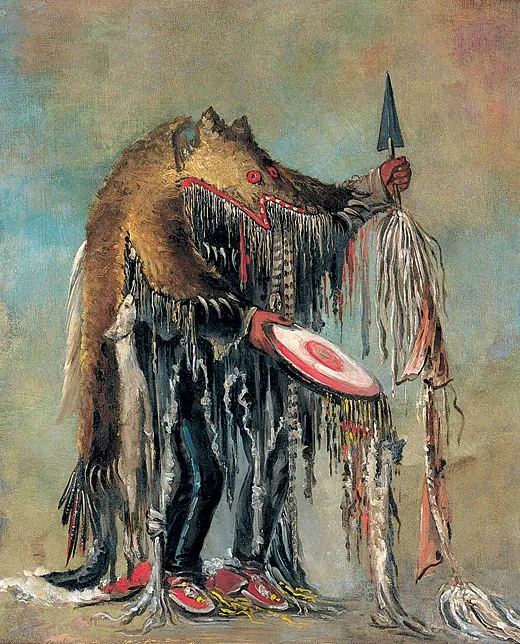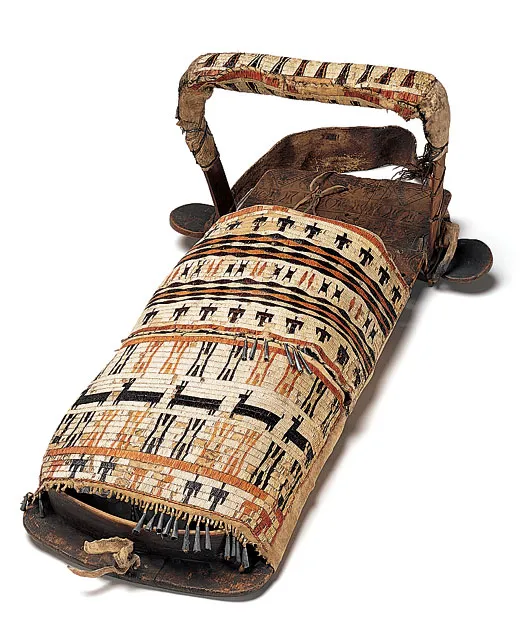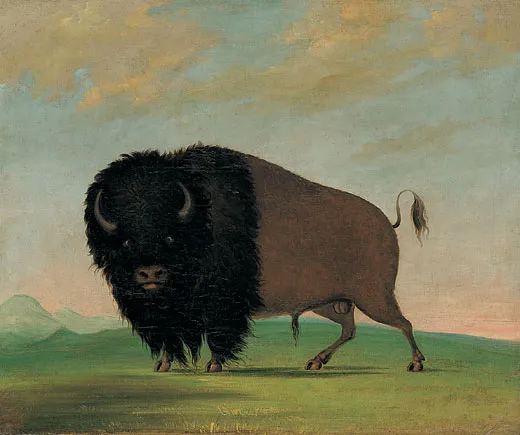George Catlin’s Obsession
An exhibition at the Renwick Gallery in Washington, D.C. asks: Did his work exploit or advance the American Indian?
One day in 1805, a 9-year-old boy exploring the woods along the Susquehanna River in southcentral New York came face-to-face with an Oneida Indian. The boy froze, terrified. Towering over him, the Indian lifted a hand in friendship. The boy never forgot the encounter or the man’s kindness. The experience may well have shaped George Catlin’s lifework.
Today Indians from nearly 50 tribes are gathered in the Renwick Gallery of the Smithsonian American Art Museum in Washington. There are Sioux, Crow, Kickapoo, Comanche, and many more, resplendent in full tribal dress. The faces of famous chiefs mix with those of young women and medicine men. A huge tepee sits in the middle of the gathering, and the sound of stampeding buffalo wafts through the galleries. Hundreds of paintings adorn the walls, accompanied by displays of artifacts—a buffalo headdress, arrows, beaded garments. At the center of it all is a lone white man—part showman, part artist—who devoted his life to preserving, in his words, “the looks and customs of the vanishing races of native man in America.”
In “George Catlin and His Indian Gallery” (through January 19, 2003), hundreds of stark, simple portraits stare impassively at visitors. The show, which also includes Catlin’s renderings of Indian rituals and landscapes of the prairie he traveled by steamboat, horseback and canoe in the 1830s, marks the first time in more than a century that Catlin’s paintings and the items he collected have been exhibited together in the manner he displayed them (1837-1850) in salons along the Eastern Seaboard and in London, Paris and Brussels. The artist, who was both heralded and criticized while he was alive, died in 1872 wondering what would happen to his gallery. “In his time, Catlin was considered a B painter, but he was a complex and fascinating figure,” says the exhibit’s cocurator George Gurney. “His collection is the largest of pre-photographic material of Native Americans. It’s an incredible record.”
Though not the first artist to paint American Indians, Catlin was the first to picture them so extensively in their own territories and one of the few to portray them as fellow human beings rather than savages. His more realistic approach grew out of his appreciation for a people who, he wrote, “had been invaded, their morals corrupted, their lands wrested from them, their customs changed, and therefore lost to the world.” Such empathy was uncommon in 1830, the year the federal Indian Removal Act forced Southeastern tribes to move to what is now Oklahoma along the disastrous “Trail of Tears.”
Catlin had little or no formal training as an artist, but he grew up hearing tales of Indians from settlers and from his own mother, who at age 7 had been abducted, along with her mother, by Iroquois during a raid along the Susquehanna in 1778. They were soon released unharmed, and Polly Catlin often told her son about the experience.
Despite a talent for drawing, Catlin (the fifth of 14 children) followed the importunings of his father, Putnam Catlin, and studied law. In 1820, he set up a practice near Wilkes-Barre, Pennsylvania, where he had been born in 1796 (though the family moved to a farm 40 miles away in New York when he was an infant). But he found himself sketching judges, juries and “culprits” in court, and after a few years he sold his law books and moved to Philadelphia to try his hand as an artist.
He earned commissions to paint the leading figures of the day, including Sam Houston and Dolley Madison, but struggled to find a larger purpose to his work. “My mind was continually reaching for some branch or enterprise of the art, on which to devote a whole lifetime of enthusiasm,” he wrote in his memoirs. He found it circa 1828, when a delegation of Indians stopped in Philadelphia en route to Washington, D.C. Captivated by “their classic beauty,” Catlin then began searching for Indian subjects. He felt that “civilization”—particularly whiskey and smallpox—was wiping them out, and he vowed that “nothing short of the loss of my life, shall prevent me from visiting their country, and of becoming their historian.” Although recently married to Clara Gregory, the daughter of a prominent Albany, New York, family, Catlin packed up his paints in 1830, left his new wife and headed west. (The Catlins, by all accounts, adored each other, and Catlin was constantly torn between devotion to his family, which in time would include four children, and his artistic ambitions.)
St. Louis was then the edge of the Western frontier, and Catlin wasn’t there long before he wrangled a meeting with the city’s most illustrious citizen, Gen. William Clark. Having already explored the Louisiana Purchase with Meriwether Lewis, Clark was then the government’s Superintendent of Indian Affairs for Western tribes. Catlin presented his early portraits to the general and asked for Clark’s assistance in making contact with Indians in the West. Clark was skeptical at first, but Catlin convinced him of the sincerity of his quest. That summer, Clark took Catlin some 400 miles up the Mississippi River to FortCrawford, where several tribes—the Sauk, Fox and Sioux among them—were having a council. Surrounded by gruff soldiers and somber Indians, whose customs were largely a mystery, Catlin took out his brushes and went to work. He would stay in the West six years, though he returned most winters to his family.
During those years, he painted 300 portraits and nearly 175 landscapes and ritual scenes. Back in New York City in 1837, he displayed them salon-style, stacked floor to ceiling, one above the other—row after row of faces identified by name and number—an arrangement to which the Renwick has been largely faithful. More than a century and a half later, there remains something startling and immediate about the faces. At first glance, they seem condemning, as if daring us to look at them without guilt. But after contemplating them awhile, they appear less forbidding. Catlin called his gallery a “collection of Nature’s dignitaries,” and dignity indeed makes certain individuals stand out. A stately Chief Kee-o-kuk of the Sauk and Fox proudly holds tomahawk, blanket and staff. La-dóo-ke-a (Buffalo Bull), a Pawnee warrior, poses commandingly in full ceremonial paint. Catlin’s landscapes are equally evocative, depicting virgin rivers and rolling hills as if from the air.
Throughout Catlin’s career, journalists tended to praise his work even as some art critics dismissed him as an “American primitive,” calling his artistry “deficient in drawing, perspective and finish.” More controversial was his attitude toward people most Americans then regarded as savages. Catlin denounced the term, calling it “an abuse of the word, and the people to whom it is applied.” He praised Indians as “honest, hospitable, faithful . . . ” and criticized the government and fur traders alike for their treatment of natives. Indian society, he wrote, “has become degraded and impoverished, and their character changed by civilized teaching, and their worst passions inflamed . . . by the abuses practiced amongst them.”
If Catlin alive stirred controversy for his championing of Native Americans, today he is as likely to be seen as an exploiter of them. “A native person is challenged, I think, not to feel on some level a profound resentment toward Catlin,” says W. Richard West, director of the Smithsonian’s National Museum of the American Indian and himself a member of the Cheyenne and Arapaho tribes. “His obsession with depicting Indians has an extremely invasive undertone to it.” As for Catlin’s relentless promotion of his gallery, West adds, “There’s no question . . . he was exploiting Indians and the West as a commodity. On the other hand, he was far ahead of his time in his empathy for Indians. Catlin swam against the tide to bring to light information about the Indians that depicts them accurately as worthy human beings and worthy cultures.”
And what did the men and women who posed for Catlin think of their portraits? Reactions to Catlin’s work varied from tribe to tribe. Sioux medicine men predicted dire consequences for those whose souls he captured on canvas, yet Blackfoot medicine men readily allowed themselves to be painted. The Mandan, awed by Catlin’s ability to render likenesses, called him Medicine White Man. Sometimes his portraits stirred up trouble. Once among the Hunkpapa Sioux on the Missouri River, he painted Chief Little Bear in profile. When the portrait was nearly finished, a rival saw it and taunted, “[The artist] knows you are but half a man, for he has painted but half of your face!” The chief ignored the affront, and when the portrait was done, he presented Catlin with a buckskin shirt decorated with porcupine quills. But the insult led to an intertribal war that claimed many lives. Some Sioux blamed Catlin and condemned him to death, but by then he had moved farther upriver.
In his six years on the prairie, Catlin survived debilitating fevers that killed his military escorts. (He later touted his travels in long-winded accounts published as travelogues.) Though most of his early work was undertaken within a few hundred miles of St. Louis, one journey took him to a place few white men had gone before. In the spring of 1832, he secured a berth on the steamboat Yellowstone, about to embark from St. Louis on a journey 2,000 miles up the Missouri River. Steaming into each Indian settlement, the Yellowstone fired its cannon, terrifying natives, who fell to the ground or sacrificed animals to appease their gods. Catlin was mesmerized by the “soulmelting scenery.” He watched great herds of buffalo, antelope and elk roaming “a vast country of green fields, where the men are all red.” In three months on the Upper Missouri, working with great speed, Catlin executed no fewer than 135 paintings, sketching figures and faces, leaving details to be finished later. In July, near what is now Bismarck, North Dakota, he became one of the few white men ever to observe the torturous fertility ritual of the Mandan tribe known as O-kee-pa, which required young men to be suspended from the top of the medicine lodge by ropes anchored to barbs skewered in their chests. When displayed five years later, Catlin’s paintings of the ceremony drew skepticism. “The scenes described by Catlin existed almost entirely in the fertile imagination of that gentleman,” a scholarly journal observed. Though Catlin was unable to corroborate his observations—smallpox had all but wiped out the Mandan not long after his visit—subsequent research confirmed his stark renderings.
In 1836, despite the vehement protests of Sioux elders, Catlin insisted on visiting a sacred, red-stone quarry in southwestern Minnesota that provided the Sioux with the bowls for their ceremonial pipes. No Indian would escort him, and fur traders, angry about his letters in newspapers condemning them for corrupting the Indians, also refused. So Catlin and a companion traveled 360 miles round-trip on horseback. The unique red pipestone he found there today bears the name catlinite. “Man feels here the thrilling sensation, the force of illimitable freedom,” Catlin wrote, “there is poetry in the very air of this place.”
Except for his run-in over the quarry, Catlin maintained excellent relations with his various hosts. They escorted him through hostile areas and invited him to feasts of dog meat, beaver tail and buffalo tongue. “No Indian ever betrayed me, struck me with a blow, or stole from me a shilling’s worth of my property. . . ,” he later wrote. By 1836, his last year in the West, Catlin had visited 48 tribes. He would spend the rest of his life trying to market his work, leading him to the brink of ruin.
On September 23, 1837, the New YorkCommercial Advertiser announced the opening of an exhibit featuring lectures by Catlin, Indian portraits, “as well as Splendid Costumes—Paintings of their villages—Dances—Buffalo Hunts—Religious Ceremonies, etc.” Admission at Clinton Hall in New York City was 50 cents, and crowds of people lined up to pay it. When the show closed after three months, the artist took it to cities along the East Coast. But after a year, attendance began to dwindle, and Catlin fell on hard times. In 1837, he tried to sell his gallery to the federal government, but Congress dawdled. So in November 1839, with Clara expecting their second child and promising to join him the following year, Catlin packed his gallery, including a buffalo-hide tepee and two live bears, and sailed for England.
In London, Brussels, and at the Louvre in Paris, he packed houses with his “Wild West” show. He hired local actors to whoop in feathers and war paint and pose in tableaux vivants. In time he was joined by several groups of Indians (21 Ojibwe and 14 Iowa) who were touring Europe with promoters. Such luminaries as George Sand, Victor Hugo and Charles Baudelaire admired Catlin’s artistry. But general audiences preferred the live Indians, especially after Catlin convinced the Ojibwe and the Iowa to reenact hunts, dances, even scalpings. In 1843, Catlin was presented to Queen Victoria in London, and two years later, to King Louis-Philippe in France. But renting halls, transporting eight tons of paintings and artifacts, and providing for his Indian entourage—as well as his family, which by 1844 included three daughters and a son—kept the painter perpetually in debt. In 1845, in Paris, Clara, his devoted wife of 17 years, contracted pneumonia and died. Then the Ojibwe got smallpox. Two died; the rest went back to the plains. The next year his 3-year-old son, George, succumbed to typhoid.
In 1848, Catlin and his daughters returned to London, where he tried to drum up interest in installing his gallery on a ship—a floating “Museum of Mankind”—that would visit seaports around the globe. But his dream came to nothing. He lectured on California’s gold rush and sold copies of his paintings, using the originals as collateral for loans. In 1852, his funds exhausted, the 56-year-old Catlin was thrown into a London debtor’s prison. His brother-in-law came to take Catlin’s young daughters back to America. The dejected artist later would write that he had “no other means on earth than my hands and my brush, and less than half a life, at best, before me.” He again offered to sell his gallery (which Senator Daniel Webster had called “more important to us than the ascertaining of the South Pole, or anything that can be discovered in the Dead Sea . . . ”) to the U.S. government. But Congress thought the price too steep, even when Catlin lowered it from $65,000 to $25,000. Finally, late that summer, Joseph Harrison, a wealthy Pennsylvania railroad tycoon for whom Catlin had secured a painting by the American historical artist Benjamin West, paid Catlin’s debts, acquired his gallery for $20,000 and shipped it from London to Philadelphia. It sat there in Harrison’s boiler factory, while Catlin—who had repaired to Paris with a handful of watercolors and a few copies of his originals that he had hidden from his creditors—set out to rebuild his life, and his gallery. From 1852 to 1860, he bounced between Europe, the Pacific Northwest and South and Central America painting Indians from the Amazon to Patagonia. Or did he? Some scholars, dubious because of the wildness of the accounts and the lack of documentation, doubt that he left Europe at all. Inany case, by 1870 the dogged artist had completed 300 paintings of South American Indians and had re-created from sketches some 300 copies of his original Indian Gallery portraits. “Now I am George Catlin again,” he wrote his brother just before returning to America in 1870. He exhibited his “Cartoon Gallery,” as he called the copies and his South American and other later works, in 1871 in New York City, but it did not draw crowds. The show, however, earned Catlin a powerful ally when it moved to the Smithsonian Institution later that year.
Although Smithsonian Secretary Joseph Henry thought Catlin’s paintings had “little value as works of art,” he needed them: a fire had just destroyed most of the Smithsonian’s collection of Indian paintings (works by John Mix Stanley and Charles Bird King). Henry offered Catlin both support and a home. For nine months, the artist, in his mid-70s, white-bearded and walking with a cane, lived in the SmithsonianCastle. In November 1872, Catlin left Washington to be with his daughters in New Jersey. He died there two months later at age 76. Among his final words were, “What will happen to my gallery?” Seven years after his death, Harrison’s widow gave the works acquired by her husband (some 450 of Catlin’s original paintings and enough buckskin and fur, war clubs, pipes, and more, to fill a third of a freight car) to the Smithsonian. The gallery was displayed there for seven years starting in 1883—the last comprehensive public show of both artifacts and paintings until this fall. Most of the works nowat the Renwick are originals, but there are also some copies from his Cartoon Collection, which was eventually returned to his daughters and later purchased by collector Paul Mellon, who gave most of it to the National Gallery of Art.
Catlin’s reputation remains as mixed today as ever. “He may end up being regarded as a B painter,” says cocurator Gurney, “but his best portraits contain a vitality and directnessthat equal almost anyone’s.” His greater contribution, undoubtedly, was his signal role in helping to change the perception of Native Americans. “Art may mourn when these people are swept from the earth,” he wrote, “and the artists of future ages may look in vain for another race so picturesque in their costumes, their weapons, their colours, their manly games, and their chase.”
